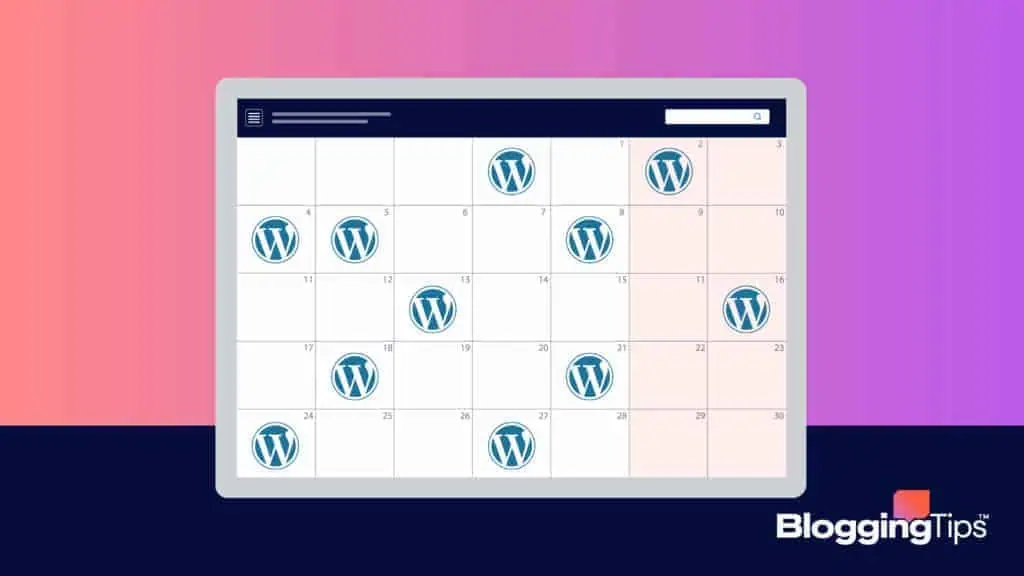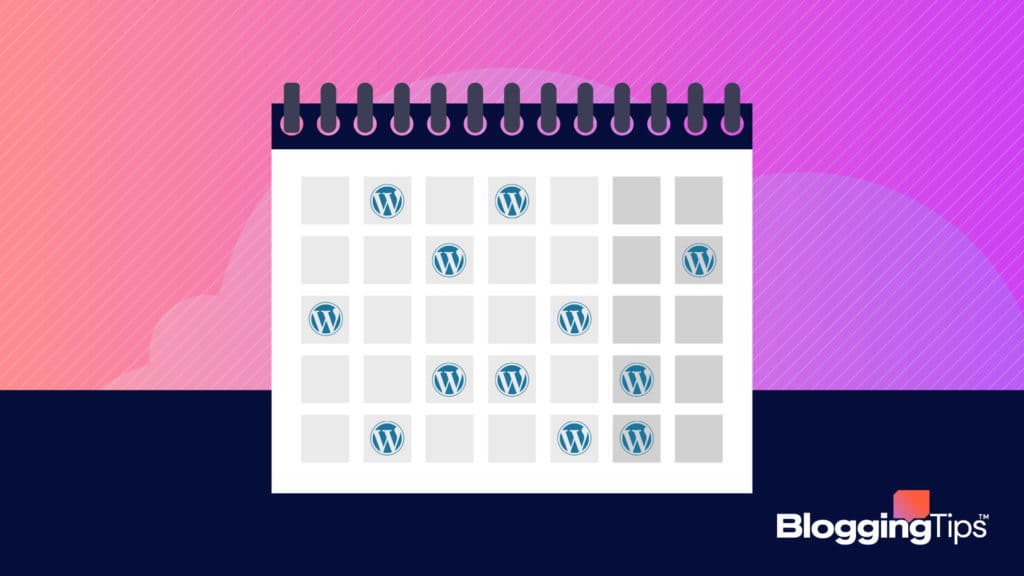
Deciding how frequently to post new blog articles is one of the many challenges that come with blogging.
If I post too infrequently, I fail to grow my audience size.
When I post too frequently, I end up producing inferior content.
Determining the ideal frequency for your posting schedule may increase your chances of success with your blog.
The following article explores how often to post on a blog for the best results.
How Often Should I Post on a Blog?
Some experts recommend posting new blog articles three times per week.
The general recommendation is about two to four times per week.
Posting frequently can help with search engine optimization (SEO) and attract new readers.
However, the frequency of your posting schedule depends on a variety of factors, including:
- Niche market
- Level of competition
- Size of the target audience
- Your goals
- The length of your posts
A niche market with lots of competition and a limited audience size may require more frequent posting compared to a market with less competition.
Is Blogging Once a Month Enough?
Blogging once per month may be enough for certain bloggers.
Posting less frequently may work well if you write in-depth, carefully researched articles.
How Often Do Successful Bloggers Post?
Successful bloggers tend to post new content at least twice per week.
However, posting more frequently can help attract a larger audience more quickly.
How Often Should I Post Blogs for SEO?
Blogging up to four times per week is considered a good medium frequency for a starting blog.
Posting two to four times per week can help you gain traction and gradually build your domain authority, which helps with organic search rankings.
How Many Blogs Should I Post Per Day?
The largest blogs, such as the Huffington Post, post new content every few minutes throughout the day.
However, the average blogger may not need to post daily to grow a successful blog.
Many blogging experts agree that publishing two to four new articles per week is sufficient for the typical blogger with a moderate following.
How Many Blog Posts Per Week for Better Search Rankings?
Sticking to the general rule of posting two to four new blog posts each week should help with search rankings.
Posting once per day is considered the maximum posting frequency.
Posting more than once per day is considered to provide diminishing returns.
You are unlikely to fully benefit from each article if you pump out multiple articles per day.
How Often Should I Blog to Make Money?
The frequency of your blogging depends heavily on your resources.
If you are a solopreneur, you may not have the time or energy to write a new blog post for each day of the week.
Pushing yourself too far can lower the quality of your content.
If your goal is to make money, you want to focus on quality over quantity.
Producing a single high-quality article that people want to share can produce better results compared to releasing a handful of short, low-quality articles.
How Long Before a Blog Becomes Profitable?
Your profitability depends largely on the number of visitors that you receive.
You need at least 1,000 page views to earn several dollars through advertisement monetization.
It may take several months of posting at least twice per week to reach 1,000 page views per day.
To earn $50 per day, you may need at least 10,000 visitors.
This could take closer to a year or longer to achieve.
When Should You Post to Your Own Blog Each Week?
Bloggers typically post new articles during the work week instead of the weekend.
People tend to be busier with leisure activities on the weekend, which results in less online activity.
Studies show that Monday morning is one of the best times of the week to post new content for increased shares.
You may also want to post new content toward the end of the week before the weekend hits.
What is the Best Day to Post on a Blog?
Thursday is considered one of the best days to share content for greater social shares.
Publishing new content on Mondays and Thursdays between 9 am and 10 am EST may help you reach more people.
How Long Should Blog Posts Be?
The ideal length for a blog post is at least 2,100 words.
Longer articles tend to perform better when it comes to search rankings and sharing.
However, the length depends on the intent of the post.
For example, shorter blog posts tend to generate more social shares.
Longer posts often generate more backlinks and achieve higher search positions.
Using a tool such as Frase.io, SurferSEO, or MarketMuse can help determine the best length for a blog post.
These tools analyze the data that you provide to assist with the blog creation process.
You can use these tools to receive recommendations for the ideal post length, meta title, description, keywords, and more.
If you want more advice on using online tools for better SEO, check out the following video on how to write an SEO blog post with Jasper and SurferSEO:
How Many Blogs Should I Have?
Before launching your blog, you may want to know how many blog posts you should have ready.
Some bloggers recommend starting a blog with 3 to 5 posts, while others recommend starting a blog with 10 to 15 posts.
Launching a blog with multiple posts gives early readers more content to browse.
It also helps with your search engine optimization (SEO), as the size of your site is one of many factors used to determine search rankings.
You may also want to know how many different blogs you should run.
Some bloggers manage multiple blogs to increase their earning potential.
However, each blog that you create adds to your total workload.
You need to continue releasing new content for any of your blogs to be successful.
This becomes more difficult when trying to run more than one blog.
How Often Should Blogs Be Updated?
Update old blog posts for SEO every 12 to 18 months.
Some SEO experts have noticed that it takes about 12 months for the typical blog post to reach its peak position in search rankings.
If you wait at least 12 months, you can ensure that the page has already reached its peak and is ready for an update.
Research the topic covered by the post while looking for any updates or major developments.
Content Freshness: The Key to Ranking Success
Content freshness is a ranking factor for Google.
Updating old content and continuing to publish new content can help boost content freshness and keep your blog relevant.
Tips for Increasing Content Publishing Frequency

Maintaining a consistent publishing schedule or increasing the frequency of your publishing requires a repeatable process.
You need to easily repeat the process of creating new content.
The following tips can help with your repeatable process:
1. Use Frase.io to Create Outlines
Create your outlines using Frase.io or another AI writing assistant tool.
These tools help you create a detailed structure for your blog article.
Creating an outline helps you keep the article focused on the main topic.
Frase and other tools also provide suggestions that can improve the quality and relevance of the article.
2. Use an AI Writing Tool
Jasper is an AI writing tool that can automatically generate content based on the information that you provide.
You receive 100% original content that mostly sounds natural.
You may need to edit the content here and there, but it saves a considerable amount of time.
3. Outsource Writing to a Content Agency
Outsourcing is a convenient way to gain more content for your blog with minimal effort.
You can pay a content agency to produce content based on your instructions.
Tips for Maximizing Results for New Content
After publishing new content, you need to get people to find it and share it.
Here are a few tips for getting better results with your new blog posts.
1. Share the Content on Social Media
Use social media accounts to promote your posts but avoid strictly releasing promotional posts.
Try to share a variety of content on your social channels.
For example, try to curate three to four helpful posts for your followers for every promotional post that you send.
You should also create new social media accounts for your blog instead of using your personal accounts.
Separating blogging and personal accounts helps avoid potential risks to your privacy and maintains a more professional image.
2. Email the Content to Your Email List
Bloggers should maintain email lists to keep their audience updated.
An email list can also help with reader retention, as it reminds visitors to return to your site.
3. Do Blog Outreach to Let Others Know About Your Content
Blog outreach involves letting established bloggers and influencers know about your content.
This may involve writing a short introductory email message that you send to the top websites in your niche.
Getting bloggers with larger follower counts to talk about your site or link to your blog can help boost your online presence and attract more visitors.
4. Use Internal Links from Existing Pages to Boost Rankings
Link to your new blog posts from existing pages to boost your search rankings.
The internal links can also help your visitors find relevant information, which may increase the chances of them coming back for more.
Wrapping Up
Deciding how often to post on a blog depends on a variety of details.
You should first consider your resources.
Avoid a posting schedule that you cannot reasonably keep up with.
Maintaining a consistent schedule helps you build your audience and climb the search rankings for your niche market.
Posting two or three times per week should help you reach your blogging goals.
If you need help maintaining your schedule, consider using Frase.io and other online tools to assist with blog creation.


Responses